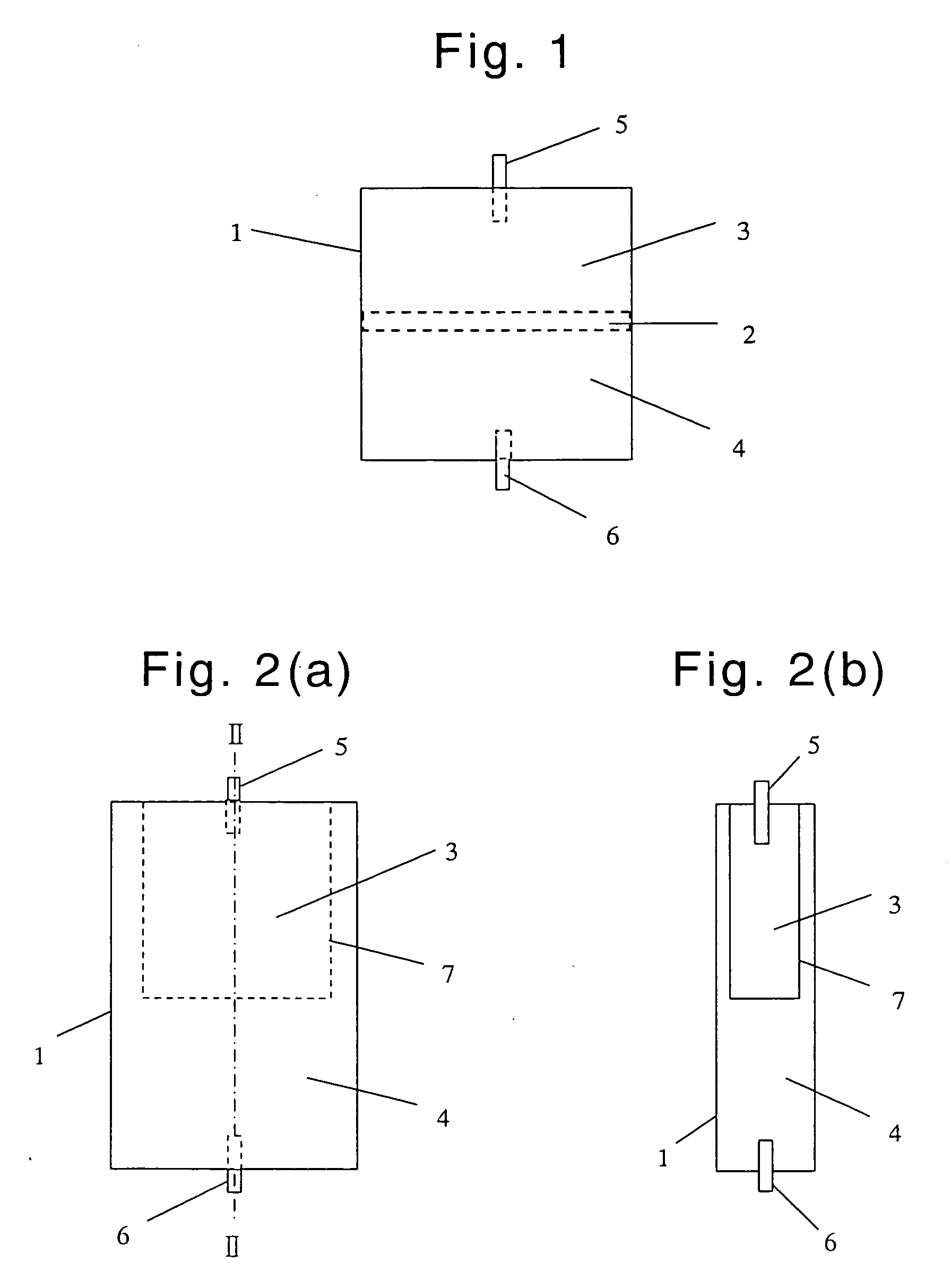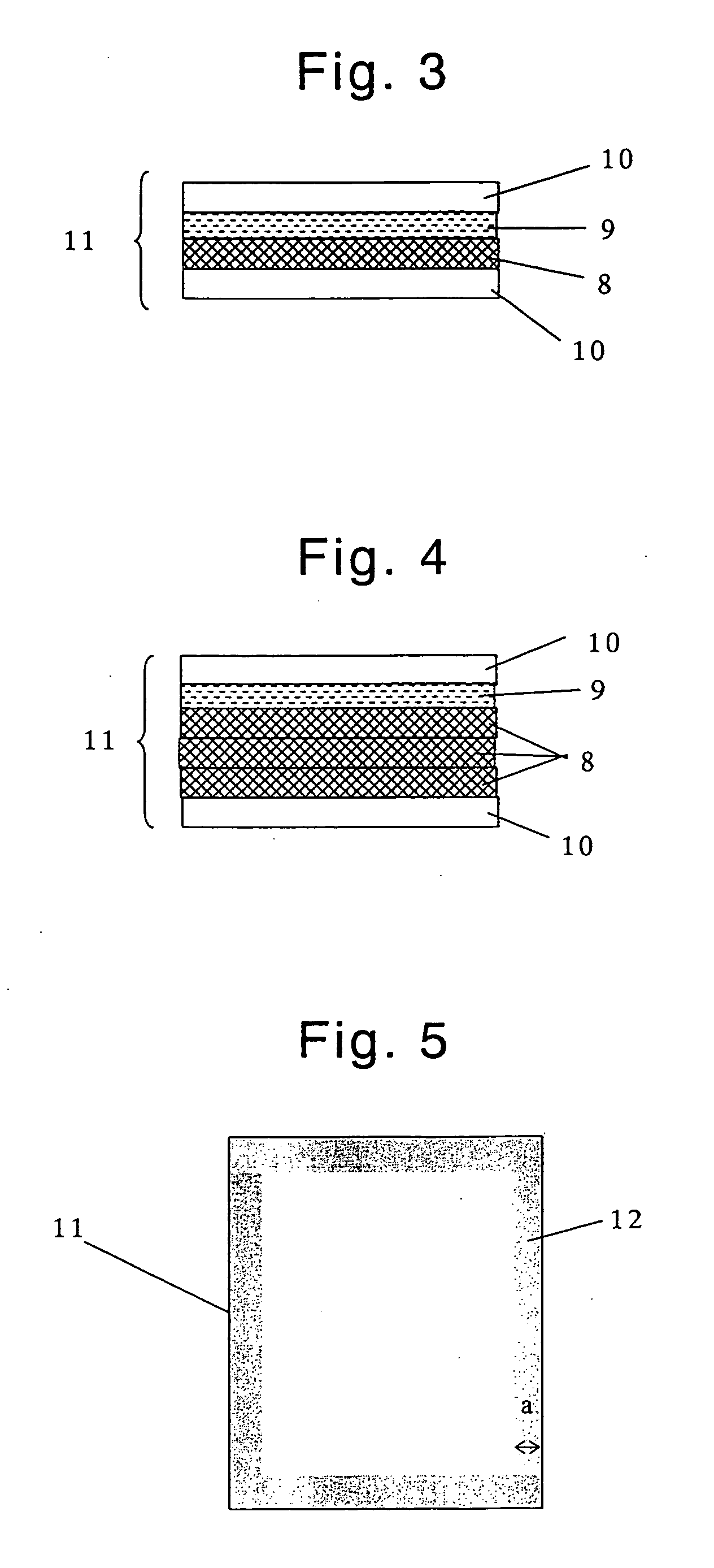Virus-removing bag and virus-removing method using the same
a virus and bag technology, applied in the field of virus removal bags, can solve the problems of unsatisfactory elimination of the possibility of viral infection from donated blood, the potential risk of contamination of plasma by viruses, and the high risk of infection of patients receiving such plasma by viruses, etc., and achieves low risk of viral infection, simple structure, and easy operation
- Summary
- Abstract
- Description
- Claims
- Application Information
AI Technical Summary
Benefits of technology
Problems solved by technology
Method used
Image
Examples
example 1
[0225] A mixture of 40% by weight of polyvinylidene fluoride resin (SOLEF1012; manufactured and sold by Solvay Solexis K. K., Japan; the crystalline melting point: 173° C.), and 60% by weight of dicyclohexyl phthalate (for industrial use; manufactured and sold by Osaka Organic Chemical Industry LTD., Japan) was subjected to melt-kneading at 200° C., using a kneader (Labo Plastomill Model C; manufactured and sold by Toyo Seiki Seisaku-sho, Ltd., Japan). The resultant molten mixture was cooled to a temperature of 30° C., or less, thereby obtaining a bulk of resin. The bulk of resin was subjected to hot-press at 200° C., under a pressure of 10 MPa, followed by cold-press under a pressure of 10 MPa, thereby obtaining a resin sheet. Subsequently, the dicyclohexyl phthalate contained in the resin sheet was removed by extraction using, as an extractant, isopropyl alcohol (special grade reagent) (manufactured and sold by Wako Pure Chemical Industries, Ltd., Japan), to thereby obtain a porou...
example 2
[0237] A virus removal bag for use in a closed, multi-bag virus removal system was produced in the same manner as in Example 1. Using the obtained virus removal bag, a closed, multi-bag virus removal system as indicated in FIG. 21 was produced. The system produced herein contained a leukocyte removal unit 22. As a leukocyte removal unit 22, a commercially available product “Sepacell” (trade name; manufactured and sold by Asahi Medical Corporation, Japan) was used.
[0238] A plasma component was separated from whole blood in substantially the same manner as in Example 1. The separated plasma component was filtered through the above-mentioned leukocyte removal unit 22, thereby obtaining leukocyte-removed plasma. The leukocyte-removed plasma was introduced into a first compartment (c) (i.e., a filter bag) of the virus removal bag (having pouchy casing 1), and then virus-removal was performed in substantially the same manner as in Example 1. With respect to the resultant virus-removed pl...
example 3
[0240] A hydrophilic porous membrane was produced in substantially the same manner as in Example 1, except:
[0241] that a polyethylene porous membrane (having an average pore diameter of 65 nm and a thickness of 20 μm) (manufactured and sold by Asahi Kasei Corporation, Japan) was used as a porous membrane (which was subjected to hydrophilicity-imparting treatment by addition-bonding of a hydrophilic compound);
[0242] that a hydrophilic compound solution was prepared by dissolving hydroxyethyl methacrylate (first grade reagent; manufactured and sold by Wako Pure Chemical Industries, Ltd., Japan) in methanol so that the final concentration of hydroxyethyl methacrylate became 50% by weight; and
[0243] that the reaction was performed at 40′ C., for 15 minutes. The hydrophilic porous membrane obtained had an average pore diameter of 58 nm.
[0244] Subsequently, a composite filter was produced in substantially the same manner as in Example 1, except that, instead of porous membrane A, the ...
PUM
 Login to View More
Login to View More Abstract
Description
Claims
Application Information
 Login to View More
Login to View More - R&D
- Intellectual Property
- Life Sciences
- Materials
- Tech Scout
- Unparalleled Data Quality
- Higher Quality Content
- 60% Fewer Hallucinations
Browse by: Latest US Patents, China's latest patents, Technical Efficacy Thesaurus, Application Domain, Technology Topic, Popular Technical Reports.
© 2025 PatSnap. All rights reserved.Legal|Privacy policy|Modern Slavery Act Transparency Statement|Sitemap|About US| Contact US: help@patsnap.com



